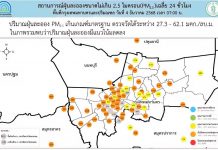
BANGKOK, Thailand – As the world watches with bated breath, the two global economic superpowers are once again locking horns in a no-holds-barred trade war. This time, China appears more prepared than ever, having stocked up its economic arsenal after the first round of battles during the Trump 1.0 era.
President Donald Trump has imposed sweeping tariffs on Chinese imports—reaching as high as 245%—while Beijing has countered with tariffs of its own, up to 125% on American goods. Consumers, businesses, and global markets are bracing for a new phase of uncertainty, and fears of a global recession are growing.
Under President Xi Jinping, China has made clear: it is open to negotiation, but fully prepared to fight to the bitter end if necessary.
Below are the five strategic weapons China is ready to deploy in response to Trump’s tariff offensive:
- Economic Resilience Through Domestic Power
As the world’s second-largest economy, China is more capable than smaller nations of absorbing the shock from tariffs. With over 1 billion people, the size of its domestic market is massive—providing a cushion to offset losses from reduced exports.
The Chinese government has introduced incentives ranging from subsidies on household appliances to “Silver Rail” projects tailored for the elderly, aimed at encouraging consumer spending. Despite cautious spending behavior from citizens, the Communist Party is tapping into nationalist sentiment, using Trump’s tariffs to stoke patriotic support and unlock consumer potential.
Additionally, China’s authoritarian system allows for greater endurance in tough times, as short-term public opinion is less of a concern compared to democratic nations.
- Betting Big on the Future
Long dubbed the world’s factory, China has poured billions into transforming itself into a global tech leader—emerging as a serious challenger to American dominance in cutting-edge industries.
Under Xi Jinping’s leadership, the country has heavily invested in domestic tech sectors, from renewable energy to microchips and artificial intelligence (AI). For instance, DeepSeek, a Chinese AI chatbot, is considered a worthy rival to America’s ChatGPT.
BYD, a Chinese EV maker, has overtaken Tesla as the world’s largest electric vehicle manufacturer. Meanwhile, Apple is losing smartphone market share in China to local giants like Huawei and Vivo.
Recently, Beijing announced a $1 trillion initiative to boost AI innovation over the next decade. And while American companies attempt to move their supply chains out of China, they’re struggling to find countries with comparable infrastructure and skilled labor.
China’s unmatched supply chain expertise, combined with strong government support, gives it a 10-year head start over its competitors, making it a formidable player in this economic war.
- Lessons Learned from Trump 1.0
Since Trump’s initial tariff on Chinese solar panels in 2018, Beijing has fast-tracked long-term strategies to reduce reliance on a U.S.-dominated global order.
China has invested billions in the Belt and Road Initiative (BRI)—a massive trade and infrastructure plan aimed at strengthening economic ties with the Global South (developing nations in Asia, Africa, and Latin America). While pulling back from economic dependence on the U.S., it’s actively boosting trade with these regions.
Today, Southeast Asia has replaced the U.S. as China’s largest export market. In 2023, China became the biggest trading partner for 60 countries, nearly twice as many as the U.S.
As the world’s largest exporter, China posted a trade surplus of $1 trillion last year. These figures make one thing clear: Washington will have a hard time forcing Beijing into a corner.
In fact, China has begun warning countries not to enter into bilateral trade deals that would harm its economy, after reports emerged that the White House may use such deals to isolate China economically.
- Targeting Trump’s Vulnerabilities
Trump has doubled down on tariffs despite turmoil in the stock market. Earlier this year, U.S. Treasury bonds—traditionally seen as safe investments—saw heavy sell-offs, prompting Trump to backtrack and delay most tariff hikes by 90 days.
Since then, Trump has hinted at de-escalation, saying tariffs on Chinese goods would be “significantly reduced”—though not entirely scrapped. Experts believe Beijing now understands how sensitive Trump is to turbulence in the bond market.
China currently holds $700 billion in U.S. Treasury bonds—the second-largest holder after Japan. Chinese media has occasionally floated the idea of selling off or freezing Treasury purchases as a way to retaliate, though experts warn such a move could backfire, causing massive losses for Beijing and destabilizing the yuan.
- The Rare Earth Knockout Punch
China’s ace in the hole? Near-total dominance over the rare earth market—materials critical to the production of high-tech devices, including smartphones, EVs, and advanced weaponry.
Beijing recently retaliated against Trump’s latest tariff threats by restricting exports of seven rare earth minerals, some of which are crucial for AI chip manufacturing.
According to the International Energy Agency (IEA), China is responsible for 61% of global rare earth production and 92% of processing.
Last year, China banned the export of antimony, a key component in many technologies, causing its price to more than double. Now, there’s growing concern that Beijing could impose similar restrictions on other rare earths—potentially halting progress across industries from electric vehicles to defense. The U.S. defense sector is particularly vulnerable to such a move.










